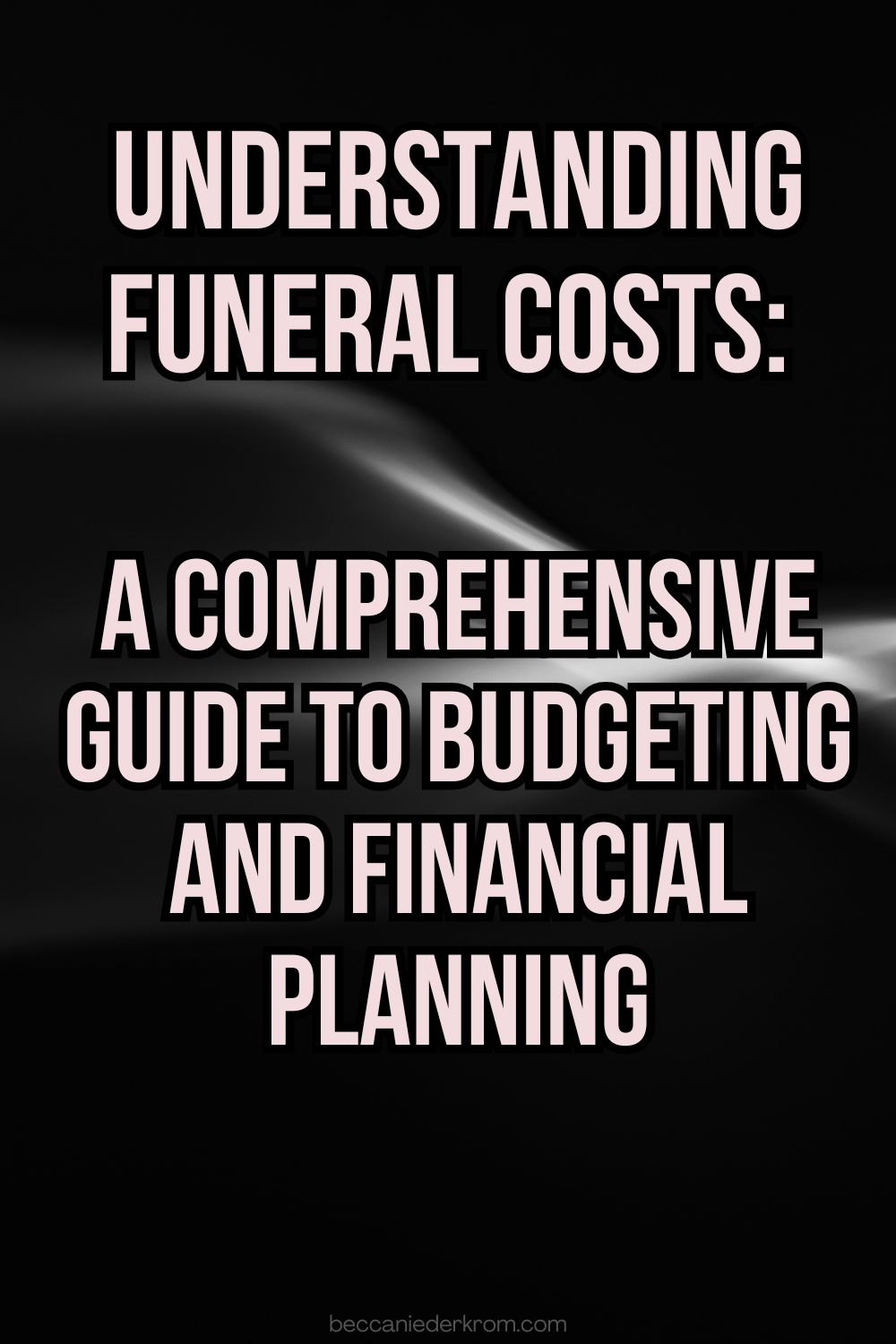We may earn money or products from the companies mentioned in this post. As an Amazon Associate I earn from qualifying purchases. Disclosure of Material Connection: Some of the links in this post may be "affiliate links." This means if you click on the link and purchase an item, I will receive an affiliate commission.
Facing the loss of a loved one brings emotional challenges that can be compounded by financial concerns. Funeral expenses often come unexpectedly, leaving families to navigate complex decisions during an already difficult time. This comprehensive guide will help you understand funeral costs, explore payment options, and develop a financial strategy that honors your loved one while maintaining financial stability.
The Reality of Understanding Funeral Costs in Today’s Economy & Understanding Funeral Expenses
The cost of funerals has steadily increased over the years, outpacing inflation in many regions. According to the National Funeral Directors Association (NFDA), the median cost of a funeral with viewing and burial is approximately $7,848, while a funeral with cremation averages about $6,970. These figures represent base costs and don’t include cemetery expenses, monuments, or markers, which can add thousands more to the final total.
Understanding these costs isn’t just about preparing for the inevitable—it’s about empowering families to make informed decisions that align with both their emotional needs and financial realities. By breaking down funeral expenses into their component parts, we can better understand where costs come from and identify opportunities for meaningful services that respect budgetary constraints.
Breaking Down Funeral Costs: What You’re Actually Paying For
Basic Services Fee
Every funeral home charges a basic services fee, which typically ranges from $2,000 to $2,500. This non-declinable fee covers:
- Funeral planning consultations
- Administrative arrangements
- Coordination with cemetery or crematory
- Securing necessary permits and death certificates
- Overhead costs of maintaining the funeral home
This fee is mandatory regardless of which specific services you select, forming the foundation of your funeral expenses.
Transportation and Care of the Deceased
Transportation costs typically include:
- Transfer of the deceased to the funeral home ($350-$500)
- Hearse for transportation to the cemetery ($350-$450)
- Service car/van for transporting flowers and equipment ($150-$250)
Care of the deceased may include:
- Embalming ($750-$900)—though this is not legally required in most cases
- Other preparation such as dressing, cosmetology, and casketing ($250-$400)
- Refrigeration if embalming is declined ($50-$100 per day)
Facility and Staff Costs
Using a funeral home’s facilities and staff for services adds significant costs:
- Viewing/visitation ($450-$600)
- Funeral ceremony at the funeral home ($500-$700)
- Graveside service ($250-$400)
- Memorial service ($450-$600)
Each of these services includes staff time, facility maintenance, and equipment use.
Merchandise
Funeral merchandise represents some of the most variable costs:
- Caskets ($2,500-$10,000+)
- Burial vaults or grave liners ($1,000-$4,000)
- Urns for cremated remains ($200-$2,000) – check out this super chic urn on a budget
- Memorial packages including guest books, prayer cards, etc. ($150-$500)
These items offer the widest range of pricing options and often present opportunities for significant savings.
Cemetery and Burial Expenses
Separate from funeral home charges, cemetery costs include:
- Cemetery plot ($1,500-$5,000+)
- Opening and closing the grave ($1,000-$2,000)
- Grave marker or headstone ($1,000-$10,000+)
- Perpetual care fees ($500-$1,500)
These expenses vary dramatically based on location, with urban cemeteries typically charging premium prices for increasingly limited space.
Cremation vs. Burial: Financial Implications & Understanding Funeral Costs
Cremation has grown in popularity partly due to its cost advantages. Direct cremation—which includes minimal services and no viewing—can cost as little as $1,000 to $2,500. This represents significant savings compared to traditional burial services.
However, it’s important to understand that cremation with additional services like viewing, memorial service, and an elaborate urn can approach or even exceed the cost of a simple burial. The financial advantage of cremation comes primarily when choosing simplified services.
Key funeral cost differences include:
- No need for embalming with direct cremation
- Elimination of casket costs (though a cremation container is required)
- No cemetery plot, opening/closing fees, or headstone expenses
- Reduced transportation costs
For families seeking to minimize expenses while still providing a dignified farewell, cremation with a memorial service later can offer both emotional closure and financial flexibility.
Pre-Planning and Pre-Funding: Strategic Approaches
Benefits of Pre-Planning
Pre-planning funeral arrangements offers several advantages:
- Financial predictability: Locking in today’s prices protects against future inflation
- Reduced emotional burden: Family members avoid making difficult decisions during grief
- Personalized choices: Ensures your specific wishes are honored
- Time for research: Allows for comparing options without time pressure
- Budget alignment: Matches funeral plans with available resources
Pre-Funding Options
Several mechanisms exist for pre-funding funeral expenses:
Funeral Trust Accounts
Funeral trusts are specifically designated accounts for funeral expenses. They offer:
- Protection from Medicaid spend-down requirements (up to state limits)
- Growth potential through conservative investments
- Portability if you move or change funeral providers
- Revocability in some cases if circumstances change
These accounts can be established through funeral homes or financial institutions, with varying terms and conditions.
Pre-Need Insurance
Pre-need insurance policies are designed specifically to cover funeral costs:
- Fixed premiums that don’t increase with age
- Death benefits that match funeral costs
- Payments made directly to the funeral provider
- Options for single-premium or multi-year payment plans
These policies often grow in value over time to offset inflation in funeral costs.
Payable-on-Death Accounts
A simple alternative is establishing a payable-on-death (POD) account at your bank:
- Designates a beneficiary to receive funds upon your death
- Avoids probate process
- Maintains your control of funds during your lifetime
- Earns interest like standard savings accounts
These accounts provide flexibility while ensuring funds are available when needed.
SNAG THE FREE FUNERAL PLANNER CHECKLIST HERE
Government and Organizational Assistance Programs
Veterans Benefits
Veterans of the U.S. armed forces may qualify for:
- Free burial in a national cemetery
- Free grave marker or headstone
- Burial allowance of up to $2,000 for service-connected deaths
- $300-$796 burial allowance for non-service-connected deaths
- Military funeral honors at no cost
These benefits can significantly reduce funeral expenses for eligible veterans and their families.
Social Security Death Benefit
The Social Security Administration provides a one-time death benefit of $255 to eligible surviving spouses or dependent children. While modest, this benefit can help offset some immediate expenses.
FEMA Disaster Assistance
In cases where death results from a federally declared disaster, FEMA may provide funeral assistance of up to $9,000 per funeral, as demonstrated during the COVID-19 pandemic.
Medicaid Funeral Assistance
Some states offer funeral assistance programs for Medicaid recipients, though coverage and eligibility vary significantly by location.
Victim Compensation Funds
When death results from a crime, state victim compensation programs may provide funeral assistance, typically ranging from $5,000 to $10,000.
SNAG THE FREE FUNERAL PLANNER CHECKLIST HERE
Practical Strategies for Managing Funeral Costs
Comparison Shopping
The Funeral Rule enforced by the Federal Trade Commission requires funeral homes to provide itemized price lists. Use this to your advantage by:
- Requesting General Price Lists from multiple funeral homes
- Comparing specific service costs rather than package prices
- Asking about price matching policies
- Considering funeral homes in neighboring communities where prices may be lower
Selective Service Choices
Customize funeral arrangements by selecting only services that hold meaning for your family:
- Consider a single-day visitation instead of multiple days
- Opt for a memorial service without the body present
- Choose morning services which may have lower facility fees
- Limit transportation to essential vehicles only
Alternative Venues
Funeral home facilities add significant costs. Consider alternative locations:
- Religious institutions often charge minimal fees for members
- Community centers or public parks for memorial gatherings
- Private homes for intimate services
- Restaurants or event spaces for celebration of life events
Casket and Merchandise Alternatives
Merchandise represents a major expense category with substantial markup:
- Purchase caskets from third-party retailers (funeral homes must accept them)
- Consider rental caskets for viewing followed by cremation
- Opt for simple urns that can be personalized in other ways
- Create your own memorial items rather than purchasing packages
Family Participation
Involving family members can reduce costs while creating meaningful experiences:
- Family-led services rather than officiant fees
- Home-prepared food instead of catering
- Digital memorial presentations created by tech-savvy relatives
- Carpooling to reduce the need for procession vehicles
Creating a Funeral Budget Worksheet
Developing a funeral budget involves several steps:
- Assess available resources:
- Life insurance proceeds
- Existing savings
- Contributions from family members
- Available credit (though using debt should be carefully considered)
- Prioritize elements based on importance:
- Essential services (transportation, disposition)
- Meaningful ceremonial aspects
- Optional elements that could be modified or eliminated
- Allocate funds across categories:
- Basic services (non-negotiable)
- Preparation and care
- Ceremony and visitation
- Merchandise
- Cemetery/crematory fees
- Identify areas for potential savings:
- Services that could be simplified
- Merchandise that could be sourced alternatively
- Timing adjustments that might reduce costs
- Document decisions and share with key individuals:
- Appointed decision-makers
- Financial power of attorney
- Funeral director
Having Difficult Financial Conversations
Discussing funeral costs requires sensitivity but is essential for financial preparation:
With Family Members
- Choose an appropriate time and setting
- Frame the conversation as an act of care, not burden
- Focus on honoring wishes within realistic parameters
- Involve multiple family members to share perspectives
- Document decisions to prevent future misunderstandings
With Funeral Directors
- Clearly communicate your budget constraints upfront
- Ask specifically about ways to reduce costs
- Request itemized explanations for all charges
- Bring a supportive person to help process information
- Take time to consider options before making commitments
Long-Term Financial Planning Considerations
Funeral expenses represent just one aspect of end-of-life financial planning:
Estate Planning Integration
- Include funeral instructions in will documents
- Designate specific funds for funeral expenses
- Appoint a trusted individual to make arrangements
- Review and update plans periodically
Insurance Considerations for funeral costs
- Evaluate whether life insurance coverage is adequate
- Consider final expense policies for specific funeral funding
- Review beneficiary designations to ensure prompt payment
Digital Legacy Planning
- Document online accounts and passwords
- Provide instructions for digital memorialization
- Consider subscription services that may continue billing
Conclusion: Balancing Cost and Meaning
Planning a funeral that honors a life while respecting financial realities requires thoughtful consideration of priorities. By understanding the components of funeral costs, exploring available assistance, and implementing strategic planning, families can create meaningful tributes without unnecessary financial strain.
Remember that the value of a funeral lies not in its cost but in how it facilitates remembrance, honors the deceased’s wishes, and supports the grieving process. With careful planning and open communication, it’s possible to achieve these important goals while maintaining financial wellbeing.
Whether you’re planning for yourself or a loved one, the time invested in understanding funeral costs and developing a sound financial strategy will provide invaluable peace of mind during one of life’s most challenging transitions.



